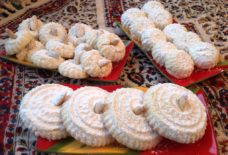New Arab-American Mural Reflects Changing Diversity of Hamtramck
On the wall outside a restaurant in southern Hamtramck, larger-than-life Yemeni faces gaze out at the neighborhood, their piercing eyes painted with people in their pupils.
The mesmerizing 80-foot-wide by 16-foot-tall mural in one of Michigan’s most diverse cities is a striking addition to the landscape of a place that has long been the home of immigrants from around the world.
Not too long ago, Hamtramck was known as a Polish enclave, but the city’s biggest immigrant group today is from Yemen, according to U.S. Census figures. To reflect that diversity, the community group One Hamtramck commissioned the mural this year to depict the Yemeni-American community. It was finished last week after a month of painting.
Dearborn has a couple of indoor murals of its Arab-American community, and there are outdoor murals in Hamtramck and southwest Detroit that depict Polish Americans and Mexican Americans. But this is thought to be the first outdoor mural in Michigan showcasing an Arab-American community.
Painted on the side of Sheeba Restaurant, it features a farmer with a yellow turban, a young girl with part of her face covered in fabric that matches the sky and a woman wearing a hijab who looks across Jos. Campau, a commercial street running through Hamtramck.
“She’s looking at the future with determination,” said Dasic Fernandez, 27, a New York City artist originally from Chile. “The mural is kind of like a cycle of life. It talks about moving, immigrating. It talks about energy. It talks about freedom, about many things at the same time.”
Fernandez, who has painted a couple of murals on the side of Hacienda Mexican Foods in southwest Detroit, first came to the city for the U.S. Social Forum in 2010, which featured activist groups from across the U.S. His work often depicts people with part of their faces covered, finding a link between protesters and Muslim women who also cover part of their heads.
He recently finished a mural in Chicago of the late Black Panther leader Fred Hampton.
Fernandez spent time listening to Yemeni Americans in Hamtramck. There was debate over what would work best. Some conservatives in the community opposed the mural’s design because they thought that depicting humans would violate Islamic guidelines about art. But many others supported it, said Bill Meyer, who organized the mural project.
The Arab American and Chaldean Council in Lathrup Village paid for a quarter of the $20,000 project, which is still seeking sponsors.
“We wanted to counter the stereotypes of Arabs,” Meyer said. “Arabs have a rich culture and have made a lot of contributions to America.”
About 24% of Hamtramck is of Arab descent, most of them from Yemen. Though Polish immigrants used to predominate, they are now the fourth largest immigrant group after Yemenis, Bangladeshis and Bosnians, according to census figures.
Yemeni motifs are woven throughout the mural, from historic buildings in the Arab country to Socatra trees unique to Yemen that look like mushrooms at a distance. The farmer’s turban has Yemeni buildings that float across the girl’s clothing and then transform into the trees that make up the woman’s hijab.
Walking around the mural on a recent afternoon were Yemeni women who wore Islamic garments that revealed only their eyes, like the girl in the mural.
“The fabric is a very important element,” Fernandez said. “Nature and people are composed of the same elements.”
Niraj Warikoo
Detroit Free Press


